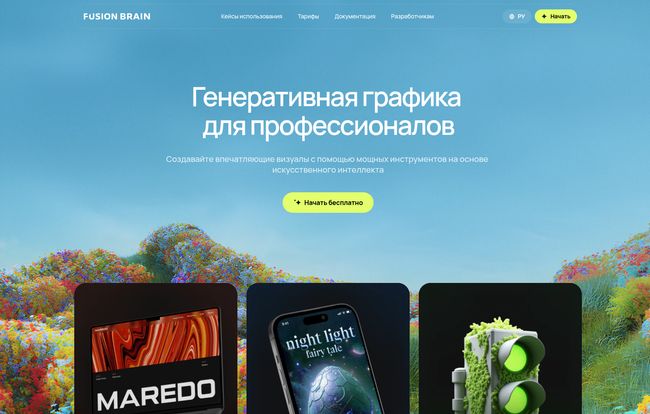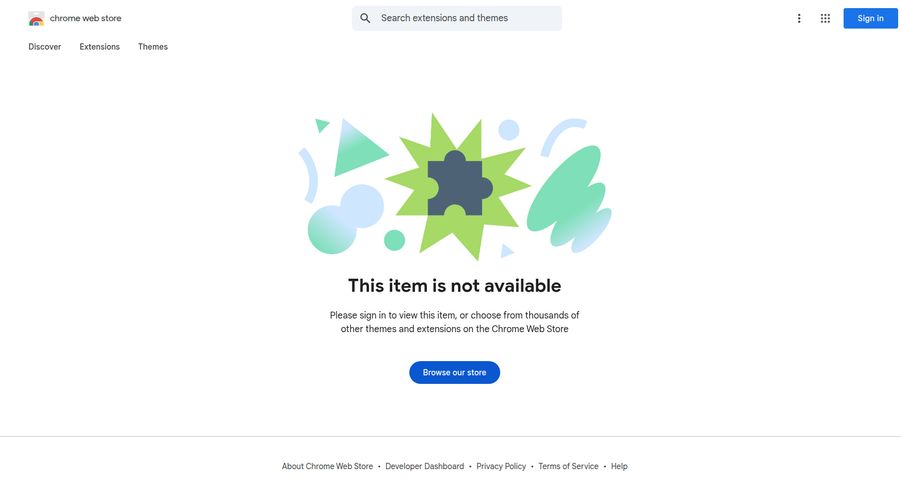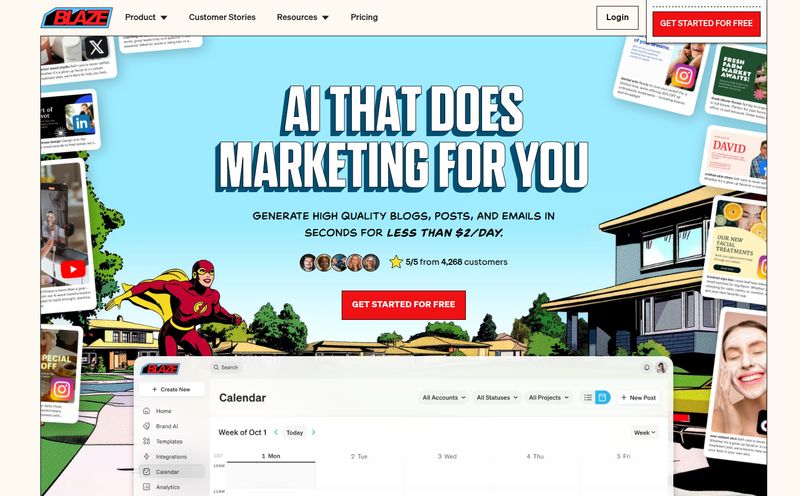If you're in the SEO, content, or marketing space, you’ve been bombarded by AI art tools for the past couple of years. It’s been a genuine gold rush. Midjourney became the darling of the artists, Stable Diffusion captured the hearts of the tech-savvy crowd, and DALL-E… well, DALL-E is still a big name. It feels like every week there's a new 'game-changer'. Honestly, it can be exhausting.
So when I stumbled upon Fusion Brain, my first thought was, “Oh great, another one.” I was skeptical. But I’ve been in this traffic generation game long enough to know that sometimes the most interesting tools aren’t the ones with the biggest marketing budgets. Sometimes, the real gems are a little off the beaten path. And Fusion Brain, powered by something called the Kandinsky neural network, definitely felt different.
So, What Exactly is Fusion Brain?
At its core, Fusion Brain is an AI platform for generating visuals. But that's a boring way of putting it. Think of it as a creative suite that uses the Kandinsky neural network to turn your text prompts into images, animations, and even short videos. The name itself, Kandinsky, should be a clue. Wassily Kandinsky was a Russian painter and art theorist, a pioneer of abstract art. It's a fitting name for a model that's trying to interpret human language into visual form. This isn't just some random name; it hints at its origins with Sber AI, a major tech company in Russia.
Unlike some platforms that feel like complex command-line interfaces, Fusion Brain presents itself as a tool for professionals—designers, content creators, and marketers. The interface is dark, sleek, and it immediately tries to show you what’s possible: branding mockups, concept art, infographics. It’s not just for making fantasy dragons (though I’m sure it can do that too).

Visit Fusion Brain
My First Spin: Getting Your Hands Dirty
The big, glowing green button says “Начать бесплатно” which, for the non-Russian speakers among us, means “Start for free.” And that’s a beautiful thing to see. There’s no immediate wall of a credit card form. You can just jump in and start creating, which is how it should be. The platform works directly in your browser, so there’s no software to download or hoops to jump through. I appreciate that. My desktop is cluttered enough as it is.
The Standout Features That Caught My Eye
Once you're in, you start to see where Fusion Brain tries to carve out its own niche. It's not just a text-to-image box.
More Than Just a Pretty Picture
This was the first thing that made me raise an eyebrow in a good way. It doesn't just do still images. It explicitly offers text-to-video and animation generation. Now, let’s be clear, we’re not talking about creating the next Pixar movie. But for generating unique b-roll, animated logos, or engaging social media content, this is a massive plus. Most other platforms either don’t offer this or have it locked behind a much higher paywall.
The Interactive Canvas: Your Digital Playground
This is probably my favorite part. Fusion Brain has an interactive canvas that supports inpainting and outpainting. What does that mean in plain English? Inpainting lets you select a part of an image you’ve generated and change it with a new prompt. Don’t like the hat on your character? Mask it out and type “a wizard’s hat.” Boom. Outpainting, or as they call it, expanding the canvas, lets you extend the image in any direction. It’s like telling a digital Bob Ross to add some happy little clouds over there, and a whole new part of the world just appears. It's incredibly powerful for getting the composition just right.
All The Usual Suspects are Here
Of course, it has the features you’d expect from any serious AI image generator. There are style presets (from Anime to Cyberpunk to “Khokhloma,” a traditional Russian wood painting style—a neat touch!), negative prompts to tell the AI what you don’t want, and various aspect ratios for whatever you're designing for, be it a blog header or an Instagram story.
Let's Talk Money: Fusion Brain Pricing
Okay, the million-dollar question… or in this case, the zero-ruble question. How much does it cost? The free plan is quite generous, but for anyone looking to use this seriously, you’ll need to look at the paid tiers. Here's how it breaks down based on their pricing page (all prices are in Russian Rubles, so I’ve added a rough USD estimate for context – this will fluctuate).
| Plan | Price (Monthly) | Images | Key Features |
|---|---|---|---|
| Free | 0 ₽ | 20 | Creative generation, but you can't save your canvas/project. |
| Standard | 499 ₽ (~$5.50 USD) | 200 | Generates 4 variants per prompt, allows you to save the canvas. |
| Pro | 3,499 ₽ (~$38 USD) | 1500 | Same as Standard, but with a much higher image count. |
The pricing is actually very competitive, especially the Standard plan. A couple of hundred images for the price of a fancy coffee is not a bad deal at all. The ability to save your canvas is the real reason to upgrade from the free tier.
The Good, The Bad, and The... Kandinsky?
No tool is perfect. After spending some time with Fusion Brain, here's my honest, no-fluff breakdown.
The Upsides
The biggest pro is the accessibility. It’s free to start and browser-based. The inclusion of video and animation, even in a basic form, is a huge differentiator. For developers, the fact that they offer API access is a massive win. You could potentially build your own applications on top of the Kandinsky model, which gets my inner nerd excited. And the editing tools, like inpainting, are genuinely useful and well-implemented.
The Not-So-Great Parts
Now for the reality check. Like many less-filtered models, the content can occasionally veer into adult or unexpected territory. It’s something to be aware of. You are also entirely reliant on the Kandinsky model. While it's a great model, it has its own quirks and stylistic biases. If you don't like its particular 'flavor' of art, you don't have other models to choose from like you might on other platforms. And for my fellow professionals, this is a big one: the terms of use require attribution. This means if you use a free-generated image on your blog or for a client, you technically need to credit Fusion Brain. This is pretty standard for free tiers but always something to check before you go commercial.
Who Is This Tool Really For?
So who should be adding Fusion Brain to their toolkit? In my opinion, it’s a fantastic platform for a few specific groups:
- Hobbyists and Creatives on a Budget: The free tier is more than enough to experiment, have fun, and generate some seriously cool art without spending a dime.
- Content Creators & Social Media Managers: The ability to quickly generate custom images, animations, and short video clips for posts is a godsend. It can really help your content stand out from the stock photo crowd.
- Developers: That API access is the real carrot on the stick. If you've ever wanted to integrate AI image generation into an app, this is a very interesting option.
For high-end graphic designers or ad agencies? It might be more of a rapid-prototyping and brainstorming tool rather than a final asset generator, mainly due to the attribution rules and the single-model limitation.
Frequently Asked Questions about Fusion Brain
- Is Fusion Brain really free to use?
- Yes, it has a free tier that gives you 20 image generations per month. For more images and features like saving your project canvas, you'll need to upgrade to a paid plan.
- What is the Kandinsky model?
- Kandinsky is a series of neural networks developed by Sber AI. It's the 'brain' behind Fusion Brain, responsible for interpreting your text prompts and creating the visual output. It's known for its ability to understand a wide range of concepts and styles.
- Can I use images from Fusion Brain for commercial projects?
- It's complicated. The free tier requires you to provide attribution back to the platform. The paid plans likely have more lenient commercial use terms, but as with any tool, you should always read the latest terms of service before using assets for a client or for-profit project.
- What are 'generations' in the pricing plans?
- A 'generation' is typically one request to the AI. On the paid plans, one prompt gives you four different image variations, and this whole process usually counts as a single 'generation' from your monthly allowance. It's a pretty good deal.
- Does it actually generate videos?
- Yes, it supports text-to-video generation. The results are typically short clips, more like animated scenes or GIFs, rather than long-form videos. It's a great feature for creating dynamic content for social media or websites.
Final Thoughts: A Worthy Contender
So, is Fusion Brain the ultimate Midjourney killer? Probably not. But it’s not trying to be. It’s carving out its own space as a versatile, accessible, and surprisingly powerful creative tool. It lowers the barrier to entry for AI art and even dips its toes into video, which is more than most of the competition can say.
I went in skeptical, but I’m walking away impressed. For zero cost, you get a powerful playground to experiment with. If you’re a content creator, a marketer, or just an AI-curious individual, you owe it to yourself to give Fusion Brain a spin. You might be surprised by what you can create.



